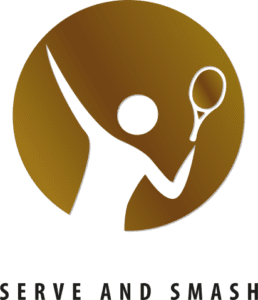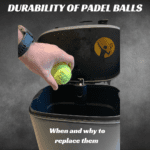This post may contain affiliate links.
While padel courts are constructed all over the world, I wondered whether there is an economic rationale for it. Based on research I came to some promising results, covered in this article.

How Profitable Are Padel Courts?
The average gross profit generated for a padel court is €29,917 for the first year, while the annual gross profit for subsequent years increases to €53,917. Variability in net profit is largely dependent on the overhead costs of the facility.
Next, we further dive into the topic of profitability as well as the underlying factors. Interested in how to improve the profitability of your padel court, jump directly to the section where I share 7 tips to improve profitability.
ROI timelines
A common indicator to gauge the health of an investment is Return on Investment, also known as ROI. This metric predicts when the benefit (revenues) outweighs the costs (investments). Based on the average numbers, there is already a profit in the first year and therefore a return on investment that is greater than 100%.
If building padel courts did not yield a decent return on investment for padel court owners, we would not see the following trend, in my estimation. The number of padel courts has increased heavily in the last few years. I have covered this in much greater detail in this article where I talk about the investments in padel courts. To give already a sneak peek of some of the trends covered in that article :
Investments of $273 mln are made between 2019-2021 in the European countries where padel is the most popular.
How Big Is The Padel Market : The numbers explained
Profitability : Define the term
In order to demonstrate how I’ve calculated the profitability, we will look at the two components that make up profit, namely revenue, and costs. Therefore, the profit generated for a padel court is the result of revenue from court rentals minus the direct and indirect costs that are associated with (running) a padel court. Note that the actual calculation for your court needs to consider all costs that are associated with the facility, including so-called overhead costs. These costs can add up for larger facilities and can thus impact the net profit (instead of gross profit) significantly.
profit generated for a padel court is the result of revenue from court rentals minus the direct and indirect costs that are associated with (running) a padel court.
Padel Court Rentals : The main source of revenue for padel court owners

The average revenue from court rental in Europe is €57,000, while this number fluctuates greatly depending on the popularity and available courts.
The average revenue for court rentals per country is based on data captured by Playtomic . The dispersion in average court rental revenue among countries in Europe can mainly be attributed to basic economics, supply and demand. This means the popularity of the sport in a country (aka demand) and the number of courts (aka supply). These drive both the court rental prices as well as the number of court reservations. If you are interested in the popularity of padel, I wrote an article that covers the popularity of padel (and squash) along the following aspects: number of players, investments, and exposure.
. The dispersion in average court rental revenue among countries in Europe can mainly be attributed to basic economics, supply and demand. This means the popularity of the sport in a country (aka demand) and the number of courts (aka supply). These drive both the court rental prices as well as the number of court reservations. If you are interested in the popularity of padel, I wrote an article that covers the popularity of padel (and squash) along the following aspects: number of players, investments, and exposure.
Within Europe, the average income per court is greatest in Sweden and is 3.8 times bigger than in Portugal. While there is quite a big gap within Europe, if we compare Portugal against another country where padel is booming, the dispersion is even greater. For example, the average income in the United Arabic Emirates (UAE) is more than 6 times bigger than in Portugal. To isolate the impact that popularity has on the average revenue per court, I first looked at the court rental prices in both countries. Even though the hourly rental price for a padel court is not the lowest in Portugal, it is more than 3 times as expensive in the UAE!
The implication is that the earning capacity is more than twice as great in UAE compared to Portugal, all remaining things equal (or ceteris paribus for those Latin lovers). The occupancy rate is another good proxy for determining the popularity of padel courts. Sure, the more courts you have per facility, the harder to fill up all courts every time, but on the other hand, it allows you to generate more revenue in total.
There are other sources of revenue for padel court owners, such as fees for events, padel lessons, equipment sales, and the sale of food and drinks. However, these revenues can be attributed to facilities and not to the court specifically.
Padel Court : Direct costs

The construction of a padel court costs on average $24,000, while an additional $3,250 is expected as direct recurring costs on an annual basis.
The total cost for building a padel court range between €18,000 and €30,000 according to Playtomic . The court construction amounts to over 70% of these total costs, while the flooring is 12.5%. The cost of transportation can vary greatly dependent on the distance between the location of the court and the manufacturers. Next to that, many transportation companies have trucks with the capacity to transport two courts at the same time, resulting in lower average costs for building two courts rather than one. Both transportation and installation costs are over 8% of the total costs. Note that some court manufacturers offer financing plans or even leasing options to make padel courts a possibility for club owners without putting down the full investment (costs) upfront.
. The court construction amounts to over 70% of these total costs, while the flooring is 12.5%. The cost of transportation can vary greatly dependent on the distance between the location of the court and the manufacturers. Next to that, many transportation companies have trucks with the capacity to transport two courts at the same time, resulting in lower average costs for building two courts rather than one. Both transportation and installation costs are over 8% of the total costs. Note that some court manufacturers offer financing plans or even leasing options to make padel courts a possibility for club owners without putting down the full investment (costs) upfront.
Next to these initial construction costs, there are some recurring costs that come with running a padel court. The maintenance of the full court consists of multiple direct costs:
- Sand It is good practice to add sand every week in order to maintain optimal levels. Find out the optimum amount of sand for your court in this article that I wrote.
- Turf This provision is kept to replace the turf every four years, which used to be a common recommendation. However proper maintenance can benefit the durability and longevity of the turf and therefore effort you put towards maintenance allows you to save dollars (in terms of new turf installment) in the long run.
- Spare parts There is always a risk that parts of the construction are damaged or broken. Think about the screw, bolts, glass, lights, and even parts of the steel construction. To (partially) remediate this risk for court owners, many manufacturers offer a guarantee (of around 10 years) for the installation of the court. Nevertheless, keeping a provision is advised in order to cover any of these replacement costs.
- Electricity for court lights While the utility bill usually does not make a distinction between the cost that is directly attributed to the energy consumption for court lights, they can be labeled as direct costs. Outdoor courts generally tend to have lower electricity costs since during daylight they are not needed. Indoor courts, on the other hand, need to be illuminated in order to allow for proper play.
Indirect costs:
- Utility costs, such as water, gas, and electricity for the facility as a whole. Think about the cafe, changing rooms and outdoor lights.
- Personnel costs, running a facility most likely means you will need some staff to manage the bookings, payments, and the facility in general.
- Other general business expenses, such as sales and marketing costs.
7 Tips To Improve The Profitability Of Your Padel Courts
- Increase court rental price
- Build more padel courts
- Increase occupancy rate
- Sale of food and beverages
- Sell the experience through arrangements and bundles
- Use energy-saving lighting
- Leverage technology
Why worry about increasing the profitability of your padel courts, well .. because at the end of the day, profitability matters.
Increase revenue (aka increase top line)
1. Increase court rental price
Revenue from court rentals for a club owner is dependent on price, occupancy, and number of courts. Increasing the court rental price is an easy lever to pull when demand (number of people that want to book a court) is high and supply (number of available courts) is low. This also explains why there is a difference in court rental prices between areas where padel is popular and areas where it is less known.
2. Build more padel courts
The construction of more padel courts seems an obvious possibility to increase revenue, but this will increase costs as well. As long as you make a profit on each additional court, there is a business rationale to do so. However, the more courts to have, the harder to fill up all of them all the time. It is still a balancing act between revenue and occupancy rate. If you have fewer courts available than demand for court rentals, you miss out on additional revenue but you would have a higher occupancy rate and a better chance to cover your costs. If on the other hand, you have more courts than there is demand, you are maximizing your revenue but you have a low occupancy rate and the recurring costs and maintenance eat into your overall profit.
You are of course limited by the number of courts you can build depending on the size of your facility. If you want to know how many padel courts you can fit in your facility, check the link and jump to the article.
3. Increase occupancy rate
Occupancy rate is defined as a percentage of actual court rental hours for a given period compared to the maximum hours of court rentals. As discussed, increasing your occupancy rate enables you to increase your revenue while simultaneously covering your costs. While there are many avenues you can take to increase occupancy rates, these are good options to consider:
- Host business events including court rentals during quiet hours
- Host social events during quiet hours
- Invite schools and sports clubs to play during quiet hours
- Off-peak rates : offer lower court rental rates during quiet hours
- Differentiate between individual court rentals and memberships to optimize the occupancy rate.
4. Sale of food and beverages
More people are required to play padel compared to tennis (singles) and squash, which also means that in general there are more people that visit the club. Since padel is a social game, the chance they are having some drinks or snacks afterward is also higher. This will increase the profitability as a result of the courts. This is of course if you use the social aspect when designing your facility. That is why I argued it is worth determining the optimal location for YOUR padel courts (in this other article).
5. Sell the experience through arrangements and bundles
While some people just want to rent a court and play, others want a nice experience. Think about all the things people need and want before, during, and after playing padel. For example, including catering in your arrangement for business or social events, directly increase the amount people spend. Offering clinics and training, next to court rental is another way to increase your revenue.
Reduce costs (aka reduce bottom line)
6. Use energy-saving lighting
While almost all new courts use LED lighting, there are cost-reduction opportunities for older facilities that do not use these energy-saving lights. These lights immediately provide maximum illumination compared to older lights which may take some time to properly light up.
The standard for padel courts is 150W/200W LED lights, compared to typical halogen spotlights of 400W. Switching to these lower-wattage LED lights alone saves 50-60% of your energy consumption.
7. Leverage technology
Using technology is about doing things faster or more efficiently and can be used for managing padel courts as well. Domotics is a network system that enables devices to be controlled and connected from a smartphone or tablet. The use of domotics allows padel club owners to manage the facility using automation :
- Provide court access to players by having them scan a QR code with their phones.
- Control cameras and alarm systems to reduce the risk of vandalism and theft during or outside opening hours.
- Manage court rental booking and payments using booking software, allowing players to book online on-demand. The added benefit of having all bookings online is to have all bookings in one place and most platforms offer reports to quickly gain insight.
- Regulate temperature and lighting remotely from your phone or regulate automatically based on certain criteria. For example, turn off court lights if there are no bookings in the next hour.
While domotics is not commonly used, there is an upwards trend especially in Norway, Finland, Denmark, and Sweden according to Playtomic . In these countries around 15% of clubs reportedly use this smart technology, while the average in Europe is only 2%.
. In these countries around 15% of clubs reportedly use this smart technology, while the average in Europe is only 2%.
When padel facilities leverage these technologies, the facility becomes more self-service. As a consequence, less staff is required to manage the facility which decreases the personnel expenses. Next to that, efficiently regulating temperature and lights, reduces the utility bill (gas and electricity). Finally, having cameras and alarm systems are likely to reduce insurance claims.






